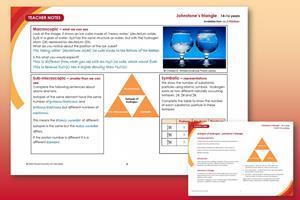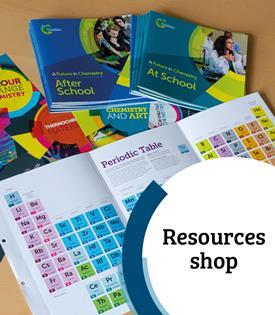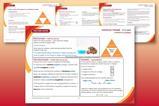Use Johnstone’s triangle to help learners differentiate between isotopes of hydrogen
With this resource, learners compare an ice cube of ‘heavy water’, containing the hydrogen isotope deuterium, with standard ice. They consider the symbolic representation of different isotopes using atomic symbols
-

Download this
Use this student worksheet to introduce isotopes of hydrogen at three different conceptual levels based on learners’ observations of 'heavy water'.
View and download more Johnstone's triangle worksheets
Learning objectives
- Determine the number of protons, neutrons and electrons in an atom from the atomic symbol.
- Recognise similarities and differences in the number of protons, neutrons and electrons between atoms and their different isotopes.
How to use Johnstone’s triangle
Use Johnstone’s triangle to develop learners’ thinking about scientific concepts at three different conceptual levels:
- Macroscopic: what we can see. Think about the properties that we can observe, measure and record.
- Sub-microscopic: smaller than we can see. Think about the particle or atomic level.
- Symbolic: representations. Think about how we represent chemical ideas including symbols and diagrams.
For learners to gain a deeper awareness of a topic, they need to understand it at all three levels.
When introducing a topic, do not try to introduce all of the levels of thinking at once. This will overload working memory. Instead complete the triangle over a series of lessons, beginning with the macroscopic level and introducing other levels, in turn, once secure.
All of the levels are interrelated, for example, learners need visual representation of the sub-microscopic in order to develop mental models of the particle or atomic level.
Further reading
Read more about how to use Johnstone’s triangle in your teaching with these articles:
- Develop deeper understanding with models
- Improve students’ understanding with Johnstone’s triangle
- Practical ideas for using Johnstone’s triangle
Norman Reid’s book The Johnstone Triangle: The Key to Understanding Chemistry provides a more in-depth overview, the first chapter is available to read online.
Scaffolding
It is important to share the structure of the triangle with learners prior to use. Tell them why you want them to use the triangle and how it will help them to develop their understanding. Use an ‘I try, we try, you try’ approach when you are introducing Johnstone’s triangle for the first time.
Next steps
To further develop learners’ thinking in all areas of Johnstone’s triangle, try our Developing understanding of atoms and isotopes worksheet. These include icons in the margin referring to the conceptual level of thinking needed to answer the question.
Downloads
Isotopes of hydrogen Johnstone's triangle student sheet
Handout | PDF, Size 0.26 mbIsotopes of hydrogen Johnstone's triangle teacher notes and answers
Handout | PDF, Size 0.29 mbIsotopes of hydrogen Johnstone's triangle student sheet
Editable handout | Word, Size 0.67 mbIsotopes of hydrogen Johnstone's triangle teacher notes and answers
Editable handout | Word, Size 0.67 mb























No comments yet